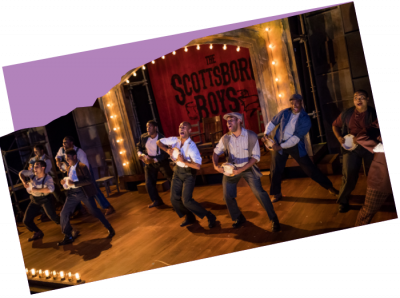Your donation sets the stage for a new season of Boston's most intimate, entertaining and provocative plays and musicals. Our shows make powerful connections with our audiences-- and they are only possible because of you.
Raising a Deaf Child: A Parent’s Perspective
Raising a Deaf Child: A Parent’s Perspective
The document cannot be copied, reproduced or distributed in any form (paper, electronic or otherwise) without the express written permission of the author.
Raising a Deaf Child: A Hearing Parent’s Perspective
 John Pirone is the Director of the Deaf Studies Program at the College of the Holy Cross in Worcester, and the former Executive Director of the Massachusetts State Association of the Deaf. He was born into a hearing family, and before passing away in 2000, his mother penned a collection of recollections and observations from the first fifteen years of his life. We are happy to present a few excerpts from her essay, in advance of our ASL-interpreted performance of Tribes on Sunday, October 6th, with a post-show discussion moderated by John.
John Pirone is the Director of the Deaf Studies Program at the College of the Holy Cross in Worcester, and the former Executive Director of the Massachusetts State Association of the Deaf. He was born into a hearing family, and before passing away in 2000, his mother penned a collection of recollections and observations from the first fifteen years of his life. We are happy to present a few excerpts from her essay, in advance of our ASL-interpreted performance of Tribes on Sunday, October 6th, with a post-show discussion moderated by John.
Introduction
Johnny was born on August 26, 1976, two and one-half months premature. Although he experienced some medical problems shortly after his birth, his overall prognosis was good. He began gaining weight, and after three months he was discharged from the hospital. The day he came home was mixed with joy and anxiety. The list of instructions for his care was overwhelming, and he required careful monitoring. Even though Johnny was not my first child, I had to approach his care as a first-time mother. It was an extremely difficult time and I constantly felt inadequate. I was so involved in his development that I felt every setback as a failure and every improvement as a personal accomplishment.
Johnny was eight months old when he began responding to me and the rest of the family. He was starting to recognize us and would smile and reach for us when we spoke to him. He was a very quiet baby, and I attributed his need to sleep and lack of verbal skills to his prematurity. My family, however, was not so sure everything was okay.
Diagnosis
Responding to my family’s concerns, I took Johnny to the first of many doctors who thought he had hearing loss. I took him in for testing, which consisted of hooking up a hearing monitor to each ear and testing for reactions to sound. The results produced two flat lines, indicating a bilateral hearing loss — a diagnosis of severe to profoundly deaf. He was also tested in a soundproof room with amplified sound. Although his responses were inconsistent, everyone involved felt he was severely hearing impaired.
My first reaction to these findings was denial. I held on to every excuse for Johnny’s unresponsiveness, rather than face the reality of what I was being told. I had worked so hard to ensure that he would live, and literally beat the odds for a normal life, that any indication that that was not the case was a personal affront to my caring.
Johnny next underwent a sophisticated x-ray process called a tomogram. He was put to sleep and x-rays showing every angle of his inner-ears were taken. In addition to showing the structure of the inner-ear, it produced a printout of nerve responses of the audio-nerve to the brain. The results came back showing perfectly formed cochleas and almost non-existent nerve stimulation. What this meant was that the ears could process the sound, but the nerve that transmits the message to the brain was dead. The results concluded that he was bi-laterally; profoundly deaf, caused by irreparable nerve damage.
No longer able to deny the truth, my denial turned to anger. I lashed out at everyone around me and subjected my family to my unbridled fury. My thoughts and feelings focused on myself, and how I had been wronged. I demanded everyone’s pity and understanding and, the more they gave, the angrier I became. I’m not sure how or when the shift in my feelings began, but after a few months my angry outbursts turned to intense sadness, and the healing process began. I stopped looking at Johnny’s deafness from how it affected me, and looked at how it affected him. I mourned his loss as if it were my own and I was finally able to separate it from myself. When my sadness passed and I came to terms with the truth of the situation, I realized I had the biggest challenge of my life ahead of me and I was ready to begin.
Oral vs. Signing
Johnny was a little over a year old when my education into the world of deafness began. I read everything I could on hearing loss, including the medical background I had already been exposed to; child development; speech development, and autobiographies of deaf people. The first and most significant decision that I needed to make concerned language. I consulted with both Children’s Hospital and Mass. Eye and Ear and learned that each advocated a different form of communication for deaf individuals. At that time, a deaf person was either taught to speak or to use sign language. The proponents of oral communication admitted that while it was decidedly more difficult for a deaf person to learn to speak, the overall advantage would be realized in their adult life when they had to function in a hearing, oral world. Sign language, on the other hand, was the language of the deaf, and allowed the hearing-impaired to communicate at an early age, thereby eliminating the frustration and failure so often experienced in the oral tradition.
Armed with a list of both types of schools, I began the task of visiting and evaluating each one. It was at this same time that I had a follow-up visit for testing at Mass. Eye and Ear. My meetings with specialists had changed, since I had done my homework and was now aware of not only the various testing procedures but also what the results meant. The audiologist and I discussed whether Johnny would be more successful in an oral program or sign language program in school. Knowing that Mass. Eye and Ear advocated sign language as a first language rather than oral, I was not surprised when the audiologist recommended a signing school. When I listened to her explanation of the severity of his hearing loss and his lack of hearing (even aided) in the speech range, I felt her bias was secondary to the information relative to Johnny. She concluded our meeting by telling me of a new concept that was evolving in deaf education, called Total Communication. She explained that it was a program that takes each individual child and determines which language is more suitable given his particular needs. It is on a first language/second language basis, which means he would be taught both oral and sign language but that more emphasis would be put on the one that was best suited for him. I was intrigued by the concept and asked for the names of the schools employing this teaching style.
The Learning Center
At that time, the only school in the Boston area whose teaching philosophy was Total Communication was The Learning Center in Framingham. It had recently been founded by a man who had lost his deaf son in a house fire and who had made a commitment to improving education for deaf children.
In my meeting at the school, I spoke to various members of the staff about Johnny’s communication, educational and developmental needs. I met with the director of the school and we talked about The Learning Center’s philosophy with respect to deafness, the deaf community, education, discipline, etc. I met with the school’s audiologist to determine what type of testing would be done, and I met with the speech therapists to discuss what techniques and programs would be used to teach Johnny to speak. The decision in the end was an easy one. The Learning Center seemed to be everything I looked for in a school. The parents already in the program were pleased not only with the progress their children were making but also with the tremendous support structure the school provided for families with deaf children. I enrolled Johnny in the infant program, which he would attend until he was three years old.
Sign Language
Johnny’s first language was sign language, which necessitated the entire family learning sign language. We did this by working with a tutor two evenings a week for two and one-half years. Johnny’s brothers picked it up very quickly, but for my husband and me it was a much slower process. Over the years, we have all become proficient at signing but it is an ongoing learning process — as Johnny’s vocabulary grows, our does as well.
Once our family learned sign language, it became apparent to me that it would be helpful if Johnny’s hearing friends and our neighbors could communicate with him, at least conversationally. I spoke to each of them and determined that there was sufficient interest in learning sign language and I began planning an eight-week course. The planning was difficult, since children can learn the language much more readily than adults, and I had to accommodate both in my classes. These first classes focused on the alphabet and words used in conversational speech. I used two books: ABC’s of Sign Language and The Joy of Signing in my classes, and found them to be very effective teaching aids. In addition to teaching sign language, we spent some time in each class talking about deafness so that everyone’s awareness was heightened. I felt this was especially important with the children so that they would be able to understand Johnny.
Personal Education
The beginning of this experience was a time of tremendous self-awareness and personal growth. Through the reading I have done, I know that my feelings at the “diagnosis” stage of this experience were quite common. There is a cycle that the human psyche goes through in the case of loss, and my processing of my son’s deafness went through the various stages of grief. I have done considerable reading on this in the years since I experienced it, and feel that what I learned became particularly poignant years later when I had to face the loss of a son.
I have spent an inordinate amount of time “educating” myself in the field of deaf education, development, communication, special education, and the family dynamics involving a handicapped child. This education encompassed developing many skills that I did not previously have or had not applied in a family orientation. I learned managing skills that would allow sufficient time for his brothers and father since Johnny required so much attention. This was particularly difficult since it was necessary to spend time away with doctors and at his school. Unlike his older brothers, I needed to attend school with him to be more effective in working with him. Oftentimes I would take his brothers with me to minimize their isolation and make them feel more a part of Johnny’s life. I joined parenting groups for parents of deaf children so I could become more responsive to his needs, particularly since it took years for him to communicate them. I also became more aware of developmental stages so that I could give feedback at his evaluations as to his progress.
Deaf Education
Knowing sign language allows me to not only speak to and understand deaf people, but it has also taught me how deaf people process information. The language of the deaf community is called American Sign Language, which does not translate into signed English. Being able to sign both has helped me with my son’s education and how he processes the information he is reading. For example, when he sees the sentence, “I will go to Chicago on the airplane,” he will interpret that as, “I airplane Chicago go I.” It is a basic way of interpreting and once I learned it, (and am still learning it) I was able to understand how Johnny was interpreting the information he was seeing and reading. I also used this information to speak at public hearings in support of American Sign Language as the language of the deaf.
Conclusion
An important part of a personal experience such as this is that there is no choice in participation. By that, I mean that we can chose to work or not work; we can chose what type of work we want to do, but in a case such as parenting a handicapped child — there are no choices. I could not turn him back in for a “normal” model, nor could I ignore the responsibility of being the best parent for him that I could possibly be.
I have to conclude this statement by adding that Johnny is one of the most interesting people I have met in my lifetime. He is a very positive adolescent with a remarkable sense of who he is and where he’s going. He does not like me to use the word handicapped or disabled. He responds by saying he’s normal — he just can’t hear.
Our life together for the past 15 years has provided me a life experience with a truly remarkable human being. If he asks you if you are deaf and you respond “no,” he will tell you he’s sorry. He goes to dances with a card telling who he is and that he would like to dance. He goes to the hospital once a month to “visit” the patients.
He has been a constant challenge and source of pleasure for me. I continue to grow by watching his ability to accept his limitations and fight to not let them impair him in any way. I see a strength of character that I marvel at and try to emulate. He’s continually frustrated when I sign too slow or hold him back from an activity because of his deafness. He tells me I have to trust him and let him live his life even though I know how difficult that will be in a world made for the hearing.
I tell him that he must be patient with me because there is still so much for me to learn. He just shrugs and signs for me to hurry up.
The document cannot be copied, reproduced or distributed in any form (paper, electronic or otherwise) without the express written permission of the author.
 Past Productions
Past Productions LAUGHS IN SPANISH
LAUGHS IN SPANISH PRU PAYNE
PRU PAYNE ain't no mo'
ain't no mo' a man of no importance
a man of no importance JAJA’S AFRICAN HAIR BRAIDING
JAJA’S AFRICAN HAIR BRAIDING




